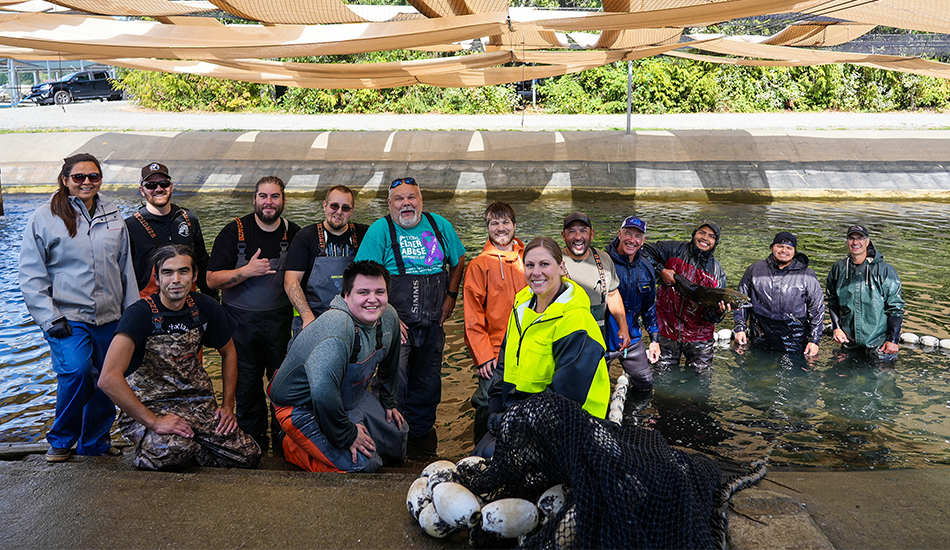Originally posted: 09/14/2023
By Sarah Bryant, Puyallup Tribal News
In a remarkable testament to nature’s enduring strength and the unwavering commitment of the Puyallup Tribal Fisheries Department, a momentous milestone was celebrated with the commencement of the fall Chinook spawning season at the Clarks Creek Hatchery. Amid the fish splashing in the acclimation pond, a chorus of voices resonated with excitement, shouting “Buck! Hen! Bingo!” as skilled Fisheries employees carried out their vital work, ensuring the continuity of this remarkable salmon run.
Fall Chinook return and spawning
The Fall Chinook journey back to the Clarks Creek Hatchery commences in mid-July, extending until the third week of October. Remarkably, the early arrivals among these fish patiently wait until September to begin their spawning rituals. To preserve genetic diversity and synchronize run-timing, the Fisheries team conducts weekly spawning sessions throughout this period. As Fisheries Enhancement Chief Blake Smith explains, “We seine the fish up to get an actual hand count of fish that have returned to date, and test by gently squeezing the bellies of females and males for ripeness.”
When a female’s eggs are deemed ripe, indicating they have loosened from the skein, they are primed for spawning. However, not all females are ripe at once. When the team encounters a ripe hen, they jubilantly exclaim “Bingo!” as a signal to their colleagues outside the pond. These ripe females (hen) are humanely euthanized and bled out, a practice that safeguards the integrity of the eggs and enhances fertilization rates when the male (buck) milt is introduced.
Egg fertilization and incubation
Out of a program goal of 2.2 million eggs, the hatchery successfully fertilized 67,000. These precious eggs are then transported to Diru Creek Hatchery where they are incubated in frigid well water.
Blake Smith elaborates on the process: “When the eggs develop eyes, we go in and count them, removing any eggs that have not fertilized. After this culling process, incubation continues until the fish hatch and absorb the yolk.” Following this stage, the fry are relocated to Clark’s Creek Hatchery raceways for feeding and nurturing. This entire journey takes 72 days from egg fertilization to the commencement of fry feeding.
A journey of growth and dedication
Blake Smith, whose journey with the department began in 1991, has witnessed the Enhancement Program’s remarkable growth. He reminisces about the early days when the office was housed in a modest three-bedroom rambler.
At that time, the program received 200,000 chum eggs and 200,000 Chinook and Coho fry from the Washington Department of Fisheries for rearing at Diru Creek Hatchery. In 1991, Fisheries made a pivotal decision to cease out-planting chum and instead release them at Diru Creek Hatchery. This strategic shift marked the inception of the first adult returns incorporating the spawning process.
Over the years, the Fisheries Program has continued to evolve. Today, it encompasses programs for Spring Chinook, Fall Chinook, Coho, and Chum, operating two hatcheries, Wilkeson Creek Rearing ponds, five acclimation ponds, and two net-pen projects. Additionally, Fisheries engages in diverse enhancement activities, including building fish ladders, removing fish-blocking culverts, screening fish from water diversions back to the river, levee setbacks, property acquisition to protect habitat and fish habitat reclamation.
Growing the team and the impact
Fisheries boasts a dedicated team of eight personnel focused on fish production, with plans to hire four fish hatchery technicians and an assistant hatchery manager. The program’s exponential growth is evident with 10 facilities strategically located throughout the watershed. Blake Smith proudly reflects on this expansion, stating, “Last year, we reared over 57,000 pounds of fish and released over 7 million salmon.”
In a world facing numerous environmental challenges, the success of the Puyallup Tribal Fisheries Department serves as an inspiring testament to the power of conservation and stewardship. As they continue their vital work, these dedicated individuals ensure the legacy of the Fall Chinook remains a vibrant and enduring part of the ecosystem they call home.
Puyallup Tribal Fisheries:
Main Contact Number: (253) 680-5560 Fishing Hotline: (253) 845-7747 Email: Fisheries@PuyallupTribe-nsn.gov
For Fisheries Jobs Contact Human Resources:
Main Contact Number: (253) 573-7863 Email: HumanResources@PuyallupTribe-nsn.gov





